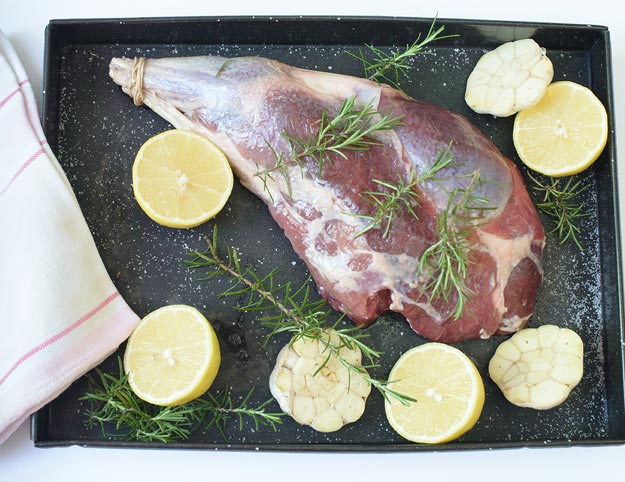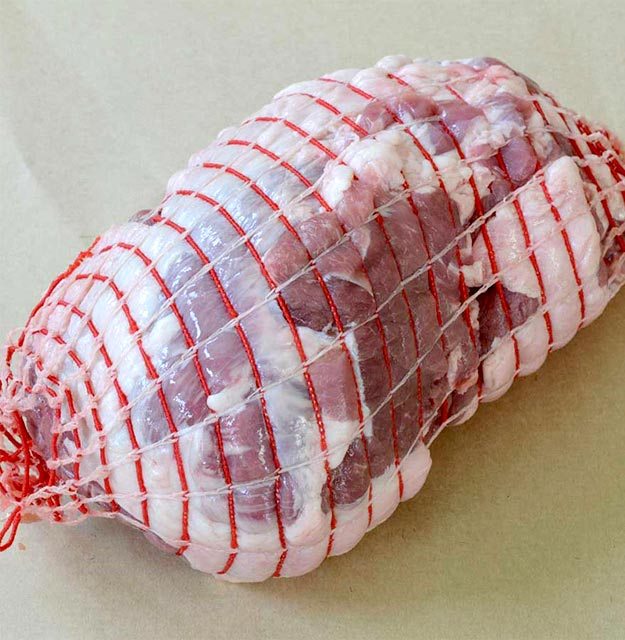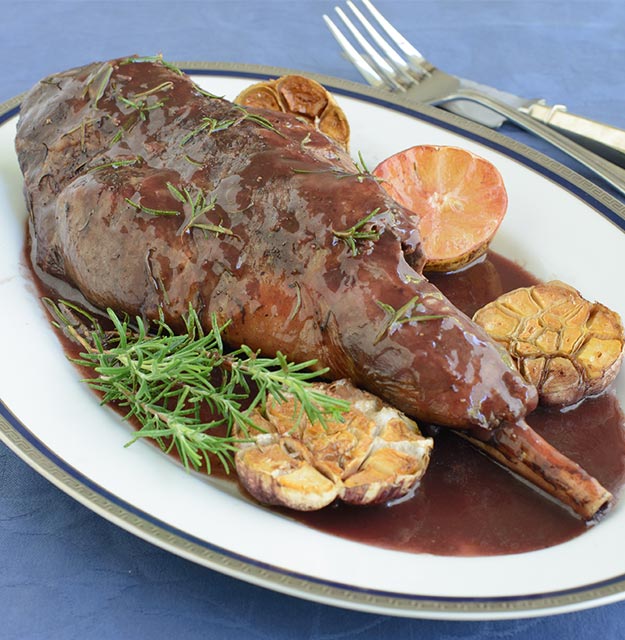A lamb roast is a classic Easter tradition, but we really don’t need an excuse to enjoy a beautifully juicy and bold-flavored New Zealand lamb leg! However, with Easter just around the corner, we wanted to give you a primer on lamb leg.

Above: a bone-in lamb leg, bone-in, with shank.
Shop New Zealand Lamb Leg, Bone-In
HOW TO ROAST A LEG OF LAMB
Roasting a lamb leg only sounds intimidating- it actually couldn’t be easier. All you need is a good-looking leg of lamb – bone in or boneless, your choice (we’ll go over the pros and cons of boneless vs. bone-in lamb leg below) – seasonings, a roasting pan, and a cutting board and sharp knife for carving. But, before you even begin, you need to make some not-so-hard choices:
- Pick your animal: American or New Zealand? This is a matter of taste. American lambs are grain-fed, usually bigger and milder in flavor. We prefer New Zealand grass-fed lamb for its bolder, more intense taste.
- Boneless or bone-in? This is actually more of a convenience issue, although some lamb connoisseurs swear that a bone-in lamb is more flavorful. Lamb is bold enough as it is, so around here we prefer the bone-in option for purely aesthetic reasons…it looks beautiful presented at the center of the table. However, it’s trickier carve and boneless lamb cooks more evenly.
- Rub the right way: salt and pepper? Rosemary and garlic? Harissa? The intensity of lamb pairs well with equally robust flavors, so you can go bold here. Just make sure you rub the lamb leg extremely, getting to all the nooks and crannies, and inside and out (if boneless or butterflied). Let the rub set in for as long as one day if possible – refrigerated- but just as long as you can. The salt especially needs time to melt into the meat.
- Cooking: slow and low, or fast and hot? Here, we have to go for slow and low. Yes, it will take longer to get that lamb leg on the table, but a longer cooking time using low heat – 200F – will ensure that you get even done-ness all around the meat, and that you won’t have a center that’s rare and an end that’s dry and overcooked. The necessary cook time will vary depending on the size of the leg and your oven, so rather than relying on a specific duration, get a good digital meat thermometer and use that. Tip: once the lamb has reached an interior temperature that you want, take it out of the oven for 15-30 minutes, turn the oven to the max, then put the lamb leg back and finish it for 15 minutes for a perfectly crispy, crackling exterior. Temperatures for lamb are below.
- Done-ness: We’re firmly in the medium-rare corner for lamb over here. Why? It’s just the perfect point; the fat has melted into the meat, making it perfectly juicy, the flavors intense, the meat rosy pink and the texture tender. Under-cook the lamb and it’ll be too rare, the meat will be tough, and that beautiful fat not rendered into the meat. Overcook lamb and you’ll have a dry, gray, and sad lump of lamb meat – a waste.

Above: a boneless leg of lamb
Buy Boneless Leg of Lamb
Inner Cooking Temperatures for Lamb
RARE-120°F(fat hasn't rendered yet, tough)
MEDIUM-RARE-130°F (PERFECT!)
MEDIUM-140°F (good, but a bit dry)
MEDIUM WELL-150°F (not good, chewy, dry)
WELL DONE-160°F (bad, overcooked)
So you’ve picked what type of lamb you want, the cut, your seasonings, and your cooking method, you’ve cooked the lamb to juicy, tender and flavorful perfection, and you’re ready to carve and serve. This, again, just LOOKS more complicated than it is.
You can carve the leg at the table if you have room and are comfortable enough, but if you’re not and would like the privacy of your own kitchen to make as much of a mess as you want, present the lovely leg at the table, let your guests oh-and-ah over it, Instagram its beauty, then take it back to the kitchen to carve.

Above: a perfectly roasted bone-in New Zealand lamb leg, before carving.
What you’ll need to carve a leg of lamb:
Long, thin carving knife or just a sharp knife
Tongs or fork
Cutting board
Platter
Tip: before your carve the leg, and as with any meat, let it rest out of the oven so the juices have time to redistribute and resettle.
How to Carve a Bone-In Roasted Leg of Lamb in 3 Easy Steps:
- Examine the leg. You’ll see the bone run almost along the middle of the leg, with large chunks of fat at either side. Start with the side you’re most comfortable with. Get a good grip on the leg, start on one end, and cut across the grain, perpendicular to the bone, cutting right until you hit the bone, in thick slices. Once you’ve reached the end, cut along the bone, where the meat is attached to the bone, to release the slices and voila.
- Start on the other end, repeating the same process.
- Fan out the beautiful slices over a platter.
- bonus! Trim the rest of the meat that’s attached to the bone, and save for snacks, stews, and sandwiches.
Ready to give it a shot? Buy premium New Zealand grass-fed lamb legs and shanks >>